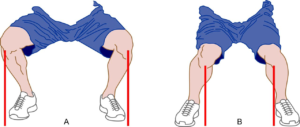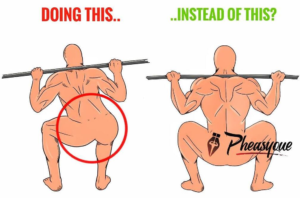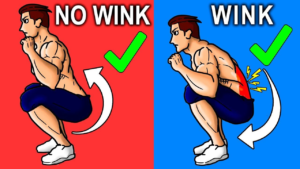Welcome to Optimal Fitness’s blog!
Let’s Learn To Squat
Why do we squat?
The squat is a movement we experience everyday! From sitting and standing to bending down to pick things up. Squats are essential for movement and are something we will continue to do throughout the entirety of our lives. It is a compound movement which burns more fat, it is a strength exercise that builds every muscle in the lower body and it is a functional movement that improves general body fluidity. The more you squat, the better off you will be!
A squat should always be performed to your comfortability. Not every squat will look the same because we all have different bodies. Some of us have longer legs, some have longer torsos, some of us might have tight hips or lack ankle mobility and some of us may be hyper mobile. The important thing is that we learn to squat to the best of our abilities with the bodies we have.
Step by Step
1. Foot Placement. Slight Toe out 11 and 1 o clock to 10 and 2. (Why? Alignment and range also helping with glute and hamstring activation) *don’t go 12 o clock or any further than 10 and 2
2. Breathing. Suck in, then brace core, exhale upon ascension. (Why? Helps engaged core, while maintaining a stable and neutral spine which is key to proper descent and ascension into a squat)
3. Break at hips and knees simultaneously. Break at the knees as hips descend don’t overreach through the butt. (Don’t stick your butt out) Why? Hips slightly before knees makes stability a breeze. Helps engaged hamstrings and glutes.
4. Equal weight distribution between heel, base of big toe and the base of the pinky toe. (Why? Helps maintain position, balance, stability and optimal power to drive straight up) *avoid “going on heels”
5. Keep spine straight. (Why? Keeps core engaged and avoids arching back. Arching back will cause low back pain.)
6. Drive knees out. (Why? Keeps knees from going in, activates hips and glutes, keeps knees in line with middle toes) *too much rotation moves foot and hips and can cause foot supination (weight on the outside of your feet.)
7. Break Parallel. Butt should go below the knees. (Why? Full activation of all muscles. Quad flexion happens when the knee bends. Muscle grows during flexion. Helps build more strength. Helps stability in lower back as well as improving flexibility.)
8. Keep head forward while driving up with shoulders on ascension. (Why? Looking up can slide the bar further down your back and put pressure on the shoulders. Looking down can cause the back to round there for breaking down core engagement.)
9. Bar should stay inline with midfoot throughout the entire squat. (Why? The quickest path anywhere is a straight line. By keeping the bar inline with the midfoot, you squat into a straight line from shoulder to foot while maintaining proper form and position with the rest of the body.)
High Bar Low Bar

Tips
Try to line up inside of foot with mid shoulder
Hands are there for support, don’t white knuckle it. Squeezing the bar too hard during a squat could hurt your elbows when you increase your weights.
If your knees are parallel with your toes, your ankle mobility will be adequate. If your knee remains at mid foot or ankle, ankle mobility could be an issue.
Don’t stand too narrow because it makes it harder to reach parallel as it makes your levers much longer.
Bring hands closer together and squeeze shoulder blades to keep from bar pressing on spine.
Knees in line with toes
Don’t let the shins stay completely vertical.
Drive up with shoulders
Always drive straight up
Common mistakes, break downs and fixes
Valgus Knee (Knee caves in) Most often caused by weak glutes

Corrective exercises:
- Hip Thrusts
- Band Walks
- Squats with a band (Press knees out for extra glute work)
Hip shift (pushing to one side upon ascension) Often caused by tightness in certain parts of the body and adductor weakness.

Corrective exercises:
- For hip tightness refer to mobility exercises.
- Lateral lunges
- Sumo deadlift
- Spanish squats
- Single leg deadlift to internal rotation of standing leg
Feet turnout on squat aka the Vinny. Is caused mostly by lack of mobility, but can sometimes be caused by weak calves.
Butt wink. Posterior/Hips tucking under pelvis causing the lower back to round at the bottom of the squat due to tight hamstrings, mobility issues or weak core.

Corrective exercises:
- Band crunches
- Weighted V-ups
- Paloff Press
- For hips, ankles and hamstrings refer to mobility exercises.
- TRX Squats
Assessments
For Ankle:
- Foot five inches from the wall and push knee forward.
- If your heel comes up before you hit the wall, your ankle mobility is poor.
For Hip:
F.A.B.E.R test (Flexion, Abduction, External, Rotation)
- Lie on your back and cross your foot over the opposite knee.
- Check if knees and hips are even.
Thomas Test
- Pull knee to chest.
- Opposite leg must remain flat and relaxed
Internal/External test
- Lie on back in sit up position
- Rotate hip inward and outward (leg should be able to reach at least 35 degrees)
For Butt Wink:
Horizontal Squat
- Feet on wall, walk hands back until hips are slightly below parallel with knees
- Feel if there are any restrictions to see if mobility is sufficient.
Counter balance
- Squat with weight in front of you
- Feel if there is tightness in ankle or hip when straightening back
Back pain when squatting
Proper Warm-up
The most important things to remember for warming up is engagement of the core, mobilization of the hips and stabilization of the ankle. These warm-ups can help in each of those primary factors in a squat in more practical functions.
Light Goblet Squats. Extend a plate out in front of you to help keep the back straight.
Lunge with core rotation.
Side to side leans in a deep squat.
Squat hip raises. Wrap your hands around your ankles and focus on lifting up through the hips.
Stretches for mobility
Hip:
(internal)
- Get into a deep squat and press knees out with elbows.
- Kneel down on all fours, spread your knees apart as far as possible and push weight towards the floor. Push butt back to intensify.
- On both knees, step one leg forward at 90 degrees. Push hip towards the ceiling. Lean back to intensify.
(external)
- Seated Cross leg hip hinge stretch
- In a seated position cross one leg on top of the other. Keep knee in line with ankle and push down on the quad. To intensify, lean forward with a straight back.
- Put both legs at 90 degrees in a seated position and raise back leg up and hold.
Glute:
- Pigeon pose, on a box or on the floor. With a straight back, lean forward to intensive.
- Knee hug and twist your upper body towards your leg.
- Lie on your back, cross one leg across the opposite knee. Lift both feet off the ground and hug leg towards your chest.
Hamstring:
- Lie on your back, wrap a strap or band around the bottom of your foot and pull your straight leg up as far as you can.
- In a split stance, push weight into straight leg and lean forward with a straight back.
- Lie on your back and put leg up straight onto a wall. Move Your body past the wall as far as you can while keeping leg straight.
- Hands behind your back, keep back and legs straight and lean forward.
Quad:
- Foot on wall with knee on the ground while the other foot is in front at 90 degrees.
- Lie face down, wrap a band around your ankle and pull your foot towards your shoulder.
- Start kneeling, put your hands on your heels and lean you body back into the heels.
Ankle:
- Raised kneeling forward lean with band.
- Seated elevated ankle rotations (clockwise and counterclockwise)
- Ankle banded flexion (with band pull around mid foot point toe out with resistance and ankle extension)
- With band on top of foot pull toes toward you with flexion at the ankle.
- With extended ankles push weight down and sit into heels.
- Deep Squat with weight, side to side rocks leaning into ankles.
ANOCIOTMOT says:
Unequivocally, excellent answer